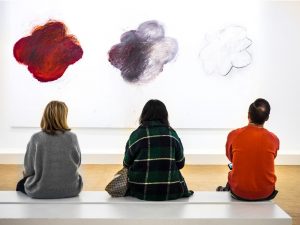
Throughout this past month in Art History, the class focus has been strictly direct to the topics of Formal Analysis and Critical Pedagogy. This two concepts are necessary if we want to understand what we see when we look at art and the way we are able to analyze, critique, judge and interpret a work of art. Formal Analysis is describing a work of art and looking for every detail in a work of art; this is to help us analyze the choices an artist has made to create art. When looking at a work of art we must focus our attention every element that is made out of. These elements consist of color, line, scale, composition, space, texture, material and historical context. The last characteristic has more to do with Contextual Analysis which is the outside research about a work of art and although the concept is important we mainly focused on Formal Analysis. This technique helps us, the viewer, to come up with a decent interpretation about a work of art and why it was made the way it was by the artist.
In class we also discussed Critical Pedagogy which is a concept created by Paolo Friere, a Brazilian educational theorist. Friere criticized the education system and the way students and teacher interacted. Friere was against the Banking Model which mainly represents the way that students learn; students brains are empty containers that are filled by the wise and knowledgeable teacher. In this kind of classroom the teacher is in charge and the student is to only sit in class not having opinions about that they are being taught. This prevent the students form making critical thinking about literature. In order to end that system, Friere came up with Critical Pedagogy which is the idea that students and teachers are equal when it comes to learning. The interaction of both teacher to student and student to teacher makes the classroom more balanced. In this way of teaching where the students have an opinion, the goal is to make the students do critical thinking about what they are being taught. In the greater good, critical pedagogy is to help students be more human and not machines when it comes to learning.
In class both of this concepts came together when we would have an opinion about a work of art that the professor put before our eyes. For example we were asked to pay attention to the elements the artist chose in The Standard of Ur. During this activity we discussed how the work of art was hallow, made out of different materials from around the world, and mainly had registers that created a story. In my cases I was able to think critically because my opinions about the work of art were backed up by physical evidence that I gathered using Formal Analysis. From now on I am more aware about what to look for when looking at art. Furthermore I am more conscious about formal analysis when I look at advertisements on the subway.







